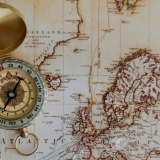Black History Matters: A Display Honoring African History
February 4, 2020
I was 19 years old when I first learned of Patrice Lumumba. Lumumba was a revolutionary individual who became the first Prime Minister of the independent Democratic Republic of Congo, helping to liberate his people from Belgian oppression. Up until this point, I had little knowledge of African history at all. African history is something not found in the history textbooks. Despite all the AP classes I took in high school, African history wasn’t apart of any it. The African continent is rich in history, which is what I intended to focus on for this display. The Omo remains discovered in Ethiopia date back 200,000 years. Cave paintings discovered in South Africa are in fact significantly older than the Lascaux cave paintings in France, making the San people some of the first human beings to create artistic expressions. The kingdoms of Egypt and Nubia were some of the most powerful ancient kingdoms in our history. Leaders like Mansa Musa established sites of education, with Timbuktu being a hub for mathematicians, astronomers, and jurists. Following European colonialism, many African nations liberated themselves through the help of leaders such as Jomo Kenyatta, Julius Nyerere, and Steve Biko. Africa is comprised of nations that are rich in history and culture. It is important that we recognize this and attempt to educate ourselves as much as we can, because Black History matters – which means African History matters too.
Note: Keep your eye out for a complementary Black History Month display curated by Ruby Blakesleay!
African History Matters Bibliography





